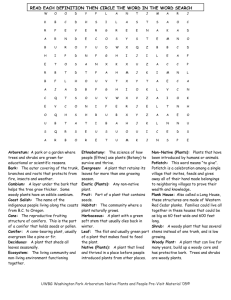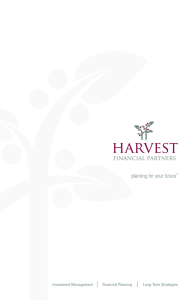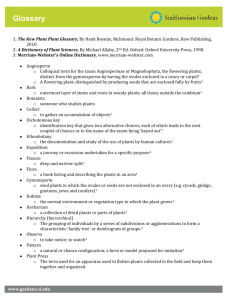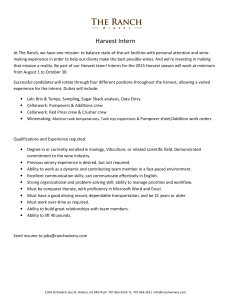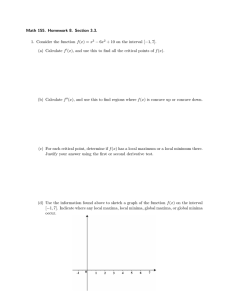Woody Stems for Cut Flower Use Richard Uva Federalsburg, Maryland
advertisement
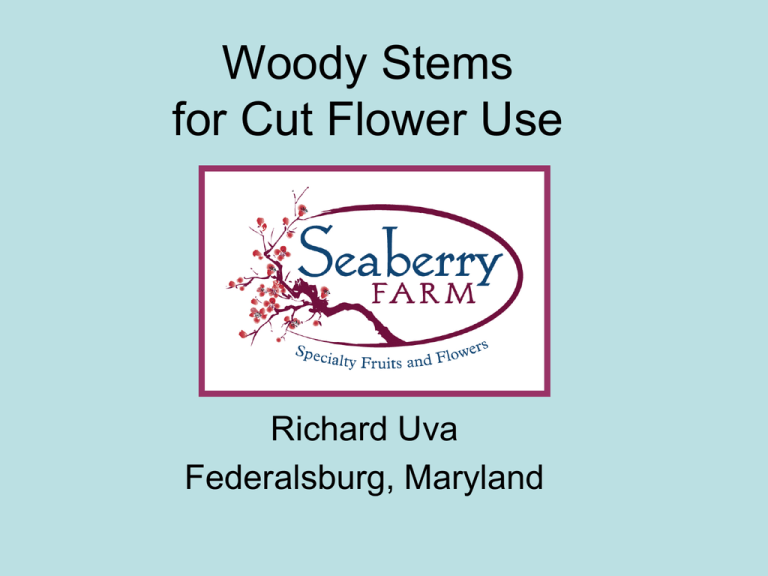
Woody Stems for Cut Flower Use Richard Uva Federalsburg, Maryland Why do florist use woody stems? To accentuate design lines. To produce a rustic or architectural look. To add contrast and interest points. To produces structure for large scale design. Florists use woody stems to decorate for holidays and seasons. Woody plants are the harbingers of seasons! – – – – Fall berries Christmas Holly Late winter pussy willow Spring lilac Some woody stem products are symbols of deep cultural significance Farmers Markets--Woodies add value to bouquets with interest and structure. History of woody cut stems • Early French (1770s) forcing whole plants in caves and later Dutch lilac forcing. • Wild-crafting evergreens, flowering dogwood, etc. • Holly orcharding in New Jersey and Notheast. • Florists, Jenkins Family in Virginia • “Bush-whackers” migrate up and down the East Coast visiting nurseries, parks, estates, etc. doing annual “pruning” and selling to wholesale florists. • And don’t let anyone forget that a rose is a woody stem... Holly Orcharding Millville, NJ Caption source: www.co.cumberland.nj.us Farm Bureau News, Volume 52, Number 2, 1 March 1993 Virginia What happened to holly orcharding? The same as everything else in the Northeast. The industry is located in Oregon now. Field layout Either plant it Like an orchard or… incorporate woody cuts into your landscape. Many suitable species are found in landscapes, hedgerows, and foundation plantings. Design your planting. Planting density pros and cons. I based my planting on current high density fruit orchard designs. High Density Planting – Many plants, each one small, less time to first harvest – You buy more liners (plug to pencil size plants) – alley hedgerow – Fabric/plastic with herbicide strips on side – 3 ft in row 12 ft for drive alley. Low density planting • 8 or more ft in row x 15 ft or more between. • Fewer plants but more years until harvest because you need to let the plants grow bigger. • Buy fewer but larger plants. • With time and growth, larger scaffold branches fill the space. • Mulch circle weed control with herbicide spot treatments. The“Big 10” products that florists want. Stem Dogwoods • Autumn-winter • Red stem dogwood “stick dogwoods” • Dieback disease • Fading of some • Harvest every year Red stem dogwood can be cut back to about 1 ft. annually Winterberry Holly • Deciduous holly for Holiday use • Ample soil moisture • Male and female plants need for berry set • Selective harvest or alternate year harvest Evergreen Holly foliage with our without berries • Limited to Christmas market • Male needed for berry set to take place. • Selective harvest Southern Magnolia • Evergreen native tree can be used year round as a green, but is especially desirable for holiday use. • Wreath use. • Grows fairly rapidly. • Hard to source liners. Quince • Early January harvest and force • Thorns • Scale has been a problem. • Selective harvest or alternate year. Forsythia • Can force in late January. • Change forcing water weekly, use preservative. • Can cut to 1 ft above ground every year. Cherry Blossom • Spring • Tent caterpillar and deer rub. • Selective harvest or alternate year harvest. Willows • Pussy Willow--spring • Curly Willow--dry or hold in cooler and use year round. • Fantail Willow--fall use • Aphids • Tolerates moisture • Harvest every year, clear cut Pussy willow Curly Willow Lilac Syringa vulgaris hybrids • Late frost caution • Pseudomonas syringae • Lilac borer • Scale • Selective harvest or alternate year harvest PeeGee “type” Hydrangeas Hydrangea paniculata grandiflora cultivars • Flowers on new wood. • Can cut back every year. • Other hydrangeas possible Harvest Orchard Byproducts Possible: some peach, cherry and apples have good blooms but this varies by variety. Look at blossoms before planting. Pests • • • • • Tent caterpillars on Prunus Deer on Malus and others Japanese beetles esp. pussy willow Aphids on willows and others Scale – Info in: The Cut Flower Quarterly, Spring 2012, Stanton Gill Lilac Problems: scale, pseudomonas, frost, fall blooming, borer! Establishment • Pre-plant soil preparation to meet your organic matter, pH and phosphorus needs. • Eradicate all perennial weeds and turf grass the year a non-selective herbicide or repeated cultivation. • Planting--March for bare root or container stock. September planting of container grown stock is ideal. Make sure your planting site and irrigation system is prepared before with before of arrival of the stock. • Irrigation and weed control is particularly important during the first season of establishment. • Remember that plant growth is exponential. If you can let these things grow for two or three years you will be rewarded with large plants. Crop Management Depending on your site and your yield needs for these crops the opportunity for very low maintance production is a possibility! • Fertilizer rates as promulgated by the Maryland Nutrient Management Program. See, Commercial Cut Flower Production, Fact sheet 808, U. Md. Extension. --I use less. • Mulch for weeds, use fabric or a combination of the above with pre- and post-emergent herbicides with woody ornamentals production on the label. Many options. • Irrigation--an inch or more per week. I recommend drip lines inthe-row with grass strips between rows. Floor Management: mulch, fabric, herbicide, plastic, mowing • Non-selective burndown herbicides don’t harm most woody plants— paraquat and diquat are for experienced pesticide handlers. • Glyphosate can only be used sparingly with a shielded sprayer under non-windy conditions. • For preemergent herbicides, I have used Snapshot (granular) Goal, Surflan, Gallery and Pendulum in both liquid and granular forms. Herbicide The best herbicide reference is: “Chemical Weed Control in Ornamentals” J. Neal, North Carolina Ag. Chemical Manual. Trusted Plant Suppliers Small cell-grown and bareroot liners Heritage Seedlings, Salem Oregon Schaeffer Nursery, Winchester, Tennessee Spring Meadow Nursery, Grand Haven, Michigan Great source of quart and gallon sized liners Cumberland Nursery, Millville, New Jersey Sources of Unusual/Rare Woody Plants Rarefind Nursery, Jackson, New Jersey Informational Resources • Bachmann, J., 2002. Woody Ornamentals for Cut Flower Growers. ATTRA, https://attra.ncat.org/ • Gill, Stanton et al., Production of Woody Plants as Cut Flowers. U. of Maryland, http://ipmnet.umd.edu/cutflower/cut_pubs.htm • Greer, L. and Dole, J.M., 2009. Woody Cut Stems for Growers and Florists. Timber Press, Inc., Portland. • Jenkins, David, F. Woody Plants as Cut Flowers. In: Proceedings of the 4th National Conference on Specialty Cut Flowers, Cleveland, Ohio, Nov. 1-4, 1991, Association of Specialty Cut Flower Growers, Inc.
